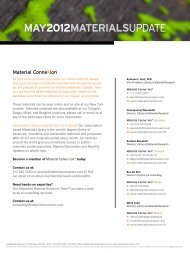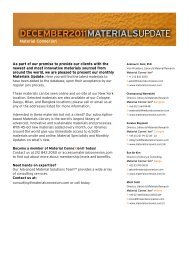48 new materials - Material ConneXion
48 new materials - Material ConneXion
48 new materials - Material ConneXion
You also want an ePaper? Increase the reach of your titles
YUMPU automatically turns print PDFs into web optimized ePapers that Google loves.
to certain structures of metals. At this temperature,<br />
which is often the lowest temperature at<br />
which a structural engineering material can be<br />
considered useful, a metal will fail in a brittle<br />
manner rather than in a ductile manner. That<br />
is, it will shatter rather than bend before giving<br />
way. The DBTT is very sensitive to alloy composition<br />
and processing. This makes it a useful<br />
criterion for quality control.<br />
The notorious catastrophe that befell the World<br />
War II Liberty ships illustrates the importance<br />
of considering DBTT. When launched in cold,<br />
northern waters, the steel hulls of the Liberty<br />
ships split in half. Evidently a hapless engineer<br />
had forgotten that the DBTT of some steel<br />
roughly coincides with the freezing point of water.<br />
Of course, one person’s catastrophe is another<br />
person’s good fortune. Aristotle Onassis<br />
purchased these ships for a pittance and, with<br />
them, created a shipping empire. He k<strong>new</strong> that<br />
in warmer, equatorial waters, they were completely<br />
safe.<br />
<strong>Material</strong>s at elevated temperatures<br />
It is important to remember that the description<br />
“solid” is a relatively general term that<br />
Brittle fracture in steel. This micrograph of the fracture<br />
surface shows the cleavage along crystal planes that<br />
absorbs little energy.<br />
refers to a range of material behaviors. On<br />
their way to becoming liquids, some solid<br />
<strong>materials</strong> transition through a viscous,<br />
gooey state (e.g. molten magma). However,<br />
long before this solid to liquid transition<br />
happens, the material loses its mechanical<br />
performance. Aluminum melts at around<br />
1220ºF but is of little use in any structural<br />
application above 360ºF. Polymers behave<br />
similarly, with the softening point typically<br />
falling at 70% of their melting point. Exceptionally,<br />
the upper limits of ceramics’<br />
operating temperatures are much closer to<br />
their melting points.<br />
<strong>Material</strong>s at low temperatures<br />
Absolute zero (0 Kelvin [0K], -273.15ºC,<br />
-459.7ºF) is as cold as anything can get. At this<br />
temperature the molecules in an object cease<br />
to move. It is actually impossible to reach this<br />
temperature, though we’ve got within a few<br />
millionths of a degree. The coldest naturally occurring<br />
place we know of is deep space, a very<br />
chilly 3K. In fact, this slight temperature elevation<br />
above 0K is the best evidence we have that<br />
the Big Bang actually occurred.<br />
The most significant change in material properties<br />
at below-ambient (or below-room) temperatures<br />
is the increasing brittleness of the<br />
material, but there are also other properties<br />
that manifest very close to 0K.<br />
These include superconductivity (which you<br />
can read about in our last issue of matter) and<br />
superfluidity, a semiconductor-like property<br />
that results in the complete loss of viscosity.<br />
This creates impressive and somewhat mindboggling<br />
effects such as: When a superfluid is<br />
placed in an open container it will rise up the<br />
sides and flow over the top. And: If the fluid’s<br />
container is rotated from stationary, the fluid<br />
Ductile fracture in the same steel. Breakage at a higher<br />
temperature is ductile. This takes a lot more energy to break.<br />
The fracture surface shows plastic deformation of the steel.<br />
inside will not move relative to the container.<br />
(In the last case, the viscosity of the liquid is<br />
zero, so any part of the liquid or its container<br />
can move at any speed without affecting any of<br />
the surrounding fluid.)<br />
The best part about most <strong>materials</strong> is that they<br />
tend to perform in ways we like them to at the<br />
temperatures that humans like. Few <strong>materials</strong><br />
are helpful to humanity at 3000ºF, but then,<br />
how many situations do you need (or want to be<br />
around) that require that kind of temperature?<br />
That said, if we decide that Mercury is a viable<br />
place to colonize, then all bets are off.<br />
MATERIAL PROFILE<br />
17 23










